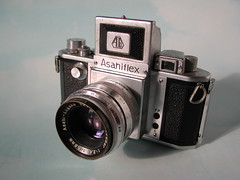Asahiflex
Asahi Optical (Pentax) had been producing camera lenses for other japanese manufactureres since 1929 [1]. The predecessors of Minolta and Konica were among their customers. Then in 1952, with no former experience in camera building[2] , they produced the first Japanese 35mm SLR, the Asahiflex. At first glance, the design of the Leica III and the Kine Exakta come to mind. The placement of the film advance and rewind knobs and the placement of the shutter speed dials bears some resemblance to the Leica III. A viewfinder separate from the optical focusing mechanism adds to that impression. Of course the Asahiflex is not a rangefinder, but a true SLR with an Exakta-style waist level finder. Nice design detail: when folded in, the hood of the waist level finder is in the same plane as the shutter dials and rewind knobs. All Asahiflex models have a nameplate reading just that one word. The different model designations apparently originate from their manuals [3]

|
| Asahiflex IIa |
Contents
Asahiflex I
Japan's first SLR had a mirror coupled to the shutter button. Press the button and the mirror goes up, release it and the mirror moves down again. This quick-but-not-yet-instant return mirror was a nice feature for 1952, when most SLRs had to be transported to get the mirror down again. The waist level finder is non-interchangable. To solve the inconvenience of a mirror-inversed image on the ground glass and to make eye-level use possible, a small optical viewfinder was on top of the camera. The angle of view for this finder was the same as for the 50mm standard lens.
The standard lens for this camera was a Takumar 50/3,5 objective with click-stop aperture (see below). Lenses can only be used with pre-set aperture.
This first version of the Asahiflex had only one flash connector, for FP bulbs [4]. The shutter speed markings for this first model are a bit odd: B, 1/20, 1/30, 1/40, 1/60, 1/100, 1/200, 1/500s. Of this early model, only about 7500 cameras are said to have been produced, and only for the Japanese market [5].
Asahiflex Ia
The Asahilfex Ia followed the original Asahiflex in 1953. A number of modifications had been made: the shutterspeed numbers hade been "normalized" to a series of B, 1/25, 1/50, 1/100, 1/200 and 1/500s. Whether this was a cosmetic change or an actual adjustment of the shutter speeds remains unclear. McKeown[6] mentions the shutter design had been simplified in this model. A second flash connector (x sync) was added above the first one. Production number: about 11.500 made[7].
The first instant return mirror?
The 1954 Asahiflex IIb is often credited for being the first SLR with an instant return mirror. It seems however a small Hungarian producer, Gamma, produced a batch of 800 cameras in 1947[8] with this feature. This Duflex had an instant return mirror and an automatic aperture. Few if any of these Hungarian cameras found their way outside of Hungary. The Asahiflex IIb was exported to the US (see below) and made in larger numbers. Let's call the Asahiflex IIb the first 35mm SLR with an instant return mirror rest the world was aware of.
Asahiflex IIa
The Asahiflex IIa has a slow speed dial on the front of the camera, just like on the [Canon Hansa] and the contemporary [Leica IIIf]. Slow speeds from 1/25 to 1/2s are now possible and this change justifies the introduction of a camera controlled instant return mirror. Suppose you were to set the shutterspeed to 1/2s and let go of the shutter button on an Asahiflex I, the miro might fold back with the shutter curtains still open.
In 1957, the Asahiflex series is discontinued in favour of the new Asahi Pentax, a rethinking of the way Pentax made SLRs.
Name Variations
As pointed out abvoe, all Asahiflexes are just marked Asahiflex. Some export Asahiflexes were rebadged "Tower" by Sears in the US. For example, The Asahiflex Ia was sold as Tower 23. So was the model IIb with the Takumar 50/3.5. This IIb with a different lens, the Takumar 58/2.4 however was sold as "Tower 24"Cite error: Invalid <ref> tag;
refs with no name must have content. Apparently the new mirror construction was less of an issue to Sears than the maximum aperture of the standard lens.
Lenses
The Asahiflexes take 37mm screw mount lenses. A 37mm screwmount is rather unique. They were named Takumar lenses after Takuma Kajiwara, a Japanese painter and uncle of the company director. [9] Apart from the curious screw mount, the Takumars have some other interesting quirks. The aperture is pre-set and made up of 20 (!) blades [10] giving a nice round lens opening. 50 and 58mm standard lenses were available and 83, 135 and 500mm telephoto lenses. No wide angle lenses were made, aparently because of the presence of the mirror in the light path[11].
References
- ↑ McKeown 10th ed, p76
- ↑ http://home.wanadoo.nl/aocn/divers/mag10.pdf article in Dutch on the development of the Asahiflex by Gerjan van Oosten
- ↑ http://pagesperso-orange.fr/Krg/index.htm under 'historique'
- ↑ McKeown, 10th ed, p 76
- ↑ http://home.wanadoo.nl/aocn/divers/mag10.pdf see ref 2
- ↑ McKeown 10th ed, p 76
- ↑ http://home.wanadoo.nl/aocn/divers/mag10.pdf see ref 2
- ↑ McKeown10th ed, p212
- ↑ http://home.wanadoo.nl/aocn/divers/mag11.pdf, nicely elaborated article on Takumar lenses, in Dutch.
- ↑ http://home.wanadoo.nl/aocn/divers/mag11.pdf see previous ref
- ↑ http://home.wanadoo.nl/aocn/divers/mag11.pdf see previous ref
Further reading
- Asahiflex and the pre-1959 Asahi Pentax cameras, F. C Sherfy, 1994, ISBN 0-9641107-5-X
- The ultimate Asahi Pentax screw mount guide, Gerjan van Oosten, 1999, ISBN 90-1244-35-x
Links
In Dutch:
- Asahiflex development
- Asahiflex model overview
- The Asahiflex Takumar lenses.
In English:
- The Asahiflex on Wikipedia.
In French:
- The Asahiflex in Krg's Pentax collection.